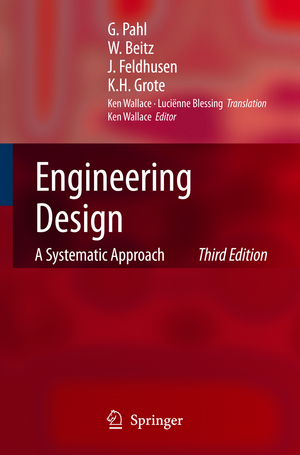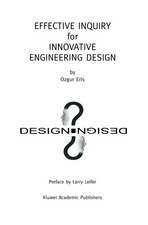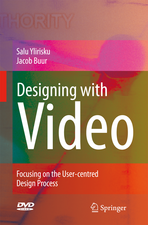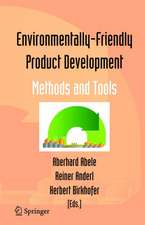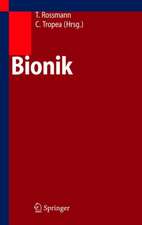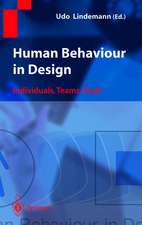Engineering Design: A Systematic Approach
Autor Gerhard Pahl, W. Beitz, Jörg Feldhusen, Karl-Heinrich Groteen Limba Engleză Hardback – 12 dec 2006
Engineering Design (3rd edition) describes a systematic approach to engineering design. The authors argue that such an approach, applied flexibly and adapted to a particular task, is essential for successful product development. The design process is first broken down into phases and then into distinct steps, each with its own working methods. The third edition of this internationally-recognised text is enhanced with new perspectives and the latest thinking. These include extended treatment of product planning; new sections on organisation structures, simultaneous engineering, leadership and team behaviour; and updated chapters on quality methods and estimating costs. New examples have been added and existing ones extended, with additions on design to minimise wear, design for recycling, mechanical connections, mechatronics, and adaptronics.
Engineering Design (3rd edition) is translated and edited from the sixth German edition by Ken Wallace, Professor of Engineering Design at the University of Cambridge, and Luciënne Blessing, Professor of Engineering Design and Methodology at the Technical University of Berlin.
Topics covered include:
- fundamentals;
- product planning and product development;
- task clarification and conceptual design;
- embodiment design rules, principles and guidelines;
- mechanical connections, mechatronics and adaptronics;
- size ranges and modular products;
- quality methods; and
- cost estimation methods.
| Toate formatele și edițiile | Preț | Express |
|---|---|---|
| Paperback (1) | 600.80 lei 6-8 săpt. | |
| SPRINGER LONDON – 4 noi 2014 | 600.80 lei 6-8 săpt. | |
| Hardback (1) | 607.33 lei 6-8 săpt. | |
| SPRINGER LONDON – 12 dec 2006 | 607.33 lei 6-8 săpt. |
Preț: 607.33 lei
Preț vechi: 714.50 lei
-15% Nou
Puncte Express: 911
Preț estimativ în valută:
116.21€ • 121.64$ • 96.73£
116.21€ • 121.64$ • 96.73£
Carte tipărită la comandă
Livrare economică 31 martie-14 aprilie
Preluare comenzi: 021 569.72.76
Specificații
ISBN-13: 9781846283185
ISBN-10: 1846283183
Pagini: 640
Ilustrații: XXI, 617 p.
Dimensiuni: 155 x 235 x 40 mm
Greutate: 1.07 kg
Ediția:3rd ed. 2007
Editura: SPRINGER LONDON
Colecția Springer
Locul publicării:London, United Kingdom
ISBN-10: 1846283183
Pagini: 640
Ilustrații: XXI, 617 p.
Dimensiuni: 155 x 235 x 40 mm
Greutate: 1.07 kg
Ediția:3rd ed. 2007
Editura: SPRINGER LONDON
Colecția Springer
Locul publicării:London, United Kingdom
Public țintă
GraduateCuprins
Fundamentals.- Product Planning, Solution Finding and Evaluation.- Product Development Process.- Task Clarification.- Conceptual Design.- Embodiment Design.- Mechanical Connections, Mechatronics and Adaptronics.- Size Ranges and Modular Products.- Design for Quality.- Design for Minimum Cost.- Summary.
Recenzii
"Engineering Design is widely acknowledged to be the most complete available treatise on systematic design methods. In it, each step of the engineering design process and associated best practices are documented. The book has particularly strong sections on design from the functional perspective and on the phase of the process between conceptual and detail design in which most key design decisions are made. The 3rd edition includes new material on project planning and scheduling. Anyone committed to understanding the design process should be familiar with the contents of this book."
Warren Seering, Weber-Shaughness Professor of Mechanical Engineering, Massachusetts Institute of Technology
On the second edition of this title:
"With a renewed interest in the critical role product design plays in maintaining economic competitiveness, American designers would be well advised to become thoroughly acquainted with this wealth of information."
American Scientist
Warren Seering, Weber-Shaughness Professor of Mechanical Engineering, Massachusetts Institute of Technology
On the second edition of this title:
"With a renewed interest in the critical role product design plays in maintaining economic competitiveness, American designers would be well advised to become thoroughly acquainted with this wealth of information."
American Scientist
Notă biografică
Dr.Ing. Gerhard Pahl graduated from the Technical College of Darmstadt in 1954 and spent the next 10 years involved with the initial start-up, construction and development of turbomachines with Brown, Boveri and Cie. During the years between 1965 and 1990, Dr.Ing. Pahl was professor for Mechanical Components and Engineering Design at the Technical College of Darmstadt. He was vice-president of the German Research Foundation from 1978 to 1984 and is a member of the Berlin Berlin-Brandenburg Academy of Sciences.
Dr.Ing. Joerg Feldhusen graduated from the Technical University of Berlin in 1989. Between 1989 and 1994 he was the department head of Electronic Design at AEG Westinghouse Transportation Systems, Berlin. He then went on to become head of design and development of the Duewag railway vehicle manufacturing company, Duesseldorf, followed by technical manager of Siemens Light Rail, Düsseldorf and Erlangen. In 1999 he was made professor forEngineering Design and in 2000 director of the Institute for General Mechanical Engineering Design Technology of the Technical College of Rhineland-Westphalia in Aachen.
Dr.Ing. Karl Grote graduated from DO Berlin in 1984 and then studied for his Postdoc in the USA. In 1990 he became professor at the California State University, Long Beach, USA, before moving to the OvG Univ. Magdeburg in 1995. From October 2002 to September 2004 he was a visiting professor at the Engineering Design Research Laboratory of Professor Erik Antonsson, CalTech, Pasadena, USA.
Dr.Ing. Joerg Feldhusen graduated from the Technical University of Berlin in 1989. Between 1989 and 1994 he was the department head of Electronic Design at AEG Westinghouse Transportation Systems, Berlin. He then went on to become head of design and development of the Duewag railway vehicle manufacturing company, Duesseldorf, followed by technical manager of Siemens Light Rail, Düsseldorf and Erlangen. In 1999 he was made professor forEngineering Design and in 2000 director of the Institute for General Mechanical Engineering Design Technology of the Technical College of Rhineland-Westphalia in Aachen.
Dr.Ing. Karl Grote graduated from DO Berlin in 1984 and then studied for his Postdoc in the USA. In 1990 he became professor at the California State University, Long Beach, USA, before moving to the OvG Univ. Magdeburg in 1995. From October 2002 to September 2004 he was a visiting professor at the Engineering Design Research Laboratory of Professor Erik Antonsson, CalTech, Pasadena, USA.
Textul de pe ultima copertă
Engineering design must be carefully planned and systematically executed. In particular, engineering design methods must integrate the many different aspects of designing and the priorities of the end-user.
Engineering Design (3rd edition) describes a systematic approach to engineering design. The authors argue that such an approach, applied flexibly and adapted to a particular task, is essential for successful product development. The design process is first broken down into phases and then into distinct steps, each with its own working methods. The third edition of this internationally-recognised text is enhanced with new perspectives and the latest thinking. These include extended treatment of product planning; new sections on organisation structures, simultaneous engineering, leadership and team behaviour; and updated chapters on quality methods and estimating costs. New examples have been added and existing ones extended, with additions on design to minimise wear, design for recycling, mechanical connections, mechatronics, and adaptronics.
Engineering Design (3rd edition) is translated and edited from the sixth German edition by Ken Wallace, Professor of Engineering Design at the University of Cambridge, and Luciënne Blessing, Professor of Engineering Design and Methodology at the Technical University of Berlin.
Topics covered include:
Engineering Design is widely acknowledged to be the most complete available treatise on systematic design methods. In it, each step of the engineering design process and associated best practices are documented. The book has particularly strong sections on design from the functional perspective and on the phase of the process between conceptual and detail design in which most key design decisions are made. The 3rd edition includes new material on project planning and scheduling. Anyone committed to understanding the design process should be familiar with the contents of this book.
Warren Seering, Weber-Shaughness Professor of Mechanical Engineering, Massachusetts Institute of Technology
Engineering Design (3rd edition) describes a systematic approach to engineering design. The authors argue that such an approach, applied flexibly and adapted to a particular task, is essential for successful product development. The design process is first broken down into phases and then into distinct steps, each with its own working methods. The third edition of this internationally-recognised text is enhanced with new perspectives and the latest thinking. These include extended treatment of product planning; new sections on organisation structures, simultaneous engineering, leadership and team behaviour; and updated chapters on quality methods and estimating costs. New examples have been added and existing ones extended, with additions on design to minimise wear, design for recycling, mechanical connections, mechatronics, and adaptronics.
Engineering Design (3rd edition) is translated and edited from the sixth German edition by Ken Wallace, Professor of Engineering Design at the University of Cambridge, and Luciënne Blessing, Professor of Engineering Design and Methodology at the Technical University of Berlin.
Topics covered include:
- fundamentals;
- product planning and product development;
- task clarification and conceptual design;
- embodiment design rules, principles and guidelines;
- mechanical connections, mechatronics and adaptronics;
- size ranges and modular products;
- quality methods; and
- cost estimation methods.
Engineering Design is widely acknowledged to be the most complete available treatise on systematic design methods. In it, each step of the engineering design process and associated best practices are documented. The book has particularly strong sections on design from the functional perspective and on the phase of the process between conceptual and detail design in which most key design decisions are made. The 3rd edition includes new material on project planning and scheduling. Anyone committed to understanding the design process should be familiar with the contents of this book.
Warren Seering, Weber-Shaughness Professor of Mechanical Engineering, Massachusetts Institute of Technology
Caracteristici
Earlier editions of this book have a very well-known reputation among engineering designers already Translated by two of the world’s most respected English-speaking engineering designers In-depth and comprehensive coverage of its subject, sharply written and well-illustrated with many examples makes this the standard textbook on engineering design, second to none Includes supplementary material: sn.pub/extras
